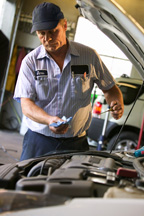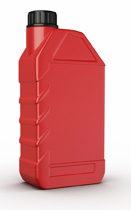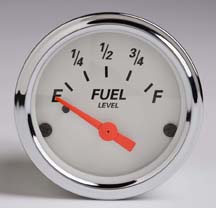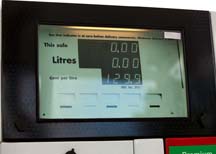Lesson 4
| Site: | MoodleHUB.ca 🍁 |
| Course: | Math 30-3 SS |
| Book: | Lesson 4 |
| Printed by: | Guest user |
| Date: | Sunday, 2 November 2025, 10:59 PM |
Description
Created by IMSreader
1. Lesson 4
Module 6: Measurement
Lesson 4: Measurement Applications and Problem Solving
Focus
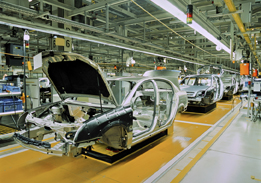
iStockphoto/Thinkstock
A motor vehicle is a complex machine that is composed of many simple machines. Regardless of complexity, in order for these machines to function properly, they require many parts working together. To ensure a vehicle functions properly many measurements are taken during the planning stages of the vehicle design, to the assembly manufacturing line, and finally to the operation of the vehicle in the owner’s hands. Think of some measurements associated with a vehicle.
In this lesson you will explore the precision, accuracy, uncertainty, and tolerance of measures related to a vehicle. You will also learn about some of the benefits and limitations of these measures.
Lesson Outcomes
At the end of this lesson you will be able to
- solve a problem that involves accuracy, precision, or tolerance
- understand accuracy, precision, uncertainty, and tolerance in connections to the real world
Lesson Questions
You will investigate the following questions:
- How do accuracy, precision, uncertainty, and tolerance connect to real-world situations?
- What limitations of measuring instruments occur in solving problems?
Assessment
Your assessment may be based on a combination of the following tasks:
- completion of the Lesson 4 Assignment (Download the Lesson 4 Assignment and save it in your course folder now.)
- course folder submissions from Try This and Share activities
- additions to Glossary Terms
- work under Project Connection
1.1. Discover
Module 6: Measurement
Discover
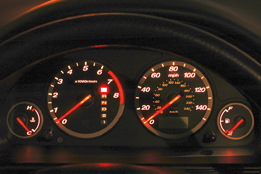
iStockphoto/Thinkstock
In previous lessons you learned about accuracy, precision, and tolerances in measurements. You learned that different situations require greater accuracy and precision than others. In this lesson you are going to apply what you learned to a variety of scenarios.
Try This 1
- The instrument panel on a vehicle’s dashboard provides several measurements that are important to the running of the vehicle. Complete the following table using measurements from a typical vehicle’s instrument panel.
Measurement
How can you estimate or determine the value?
Type of measurement
How important is it to know this measurement?
fuel
fuel gauge
volume
very important
- Using the measurements from question 1, complete the following chart. Part of the chart is completed as an example.
Measurement
Reason
Accuracy

least accurate
most accurate
Precision

least precise
most precise
odometer
• usually shown accurate to 0.1 km
Uncertainty

lowest uncertainty
odometer
• usually shown accurate to 0.1 km greatest uncertainty
Tolerance

lowest tolerance
greatest tolerance
![]() Save your responses in your course folder.
Save your responses in your course folder.
Share 1
With a partner or in a group, consider your answers to Try This 1 and answer the following questions.
- Did all of you think the same measures were important? Explain.
- Were your rankings of accuracy, precision, uncertainty, and tolerance similar? Explain.
- Are the most important measurements always the most accurate and precise? Explain.
![]() If required, place a summary of your discussion in your course folder.
If required, place a summary of your discussion in your course folder.
1.2. Explore
Module 6: Measurement
Explore
In Try This 1 you explored some of the different measurements related to a vehicle and analyzed their accuracy and precision. You likely identified the temperature of the engine as one measurement that is important for the running of the vehicle. You will now apply your knowledge of accuracy and precision to various temperature measurements in Try This 2.
Try This 2
Consider a car with these characteristics related to temperature, and then answer the questions that follow.
| Car Characteristics | |
| Engine Temperature |
|
| Block Heater |
|
| Internal Temperature of Car |
|
| Outdoor Temperature |
|
| 10W30 Engine Oil |
|
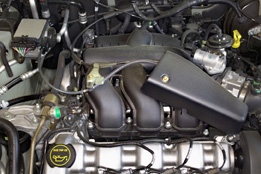
Comstock/Thinkstock
- Determine the precision and uncertainty of the engine temperature, internal temperature, and outdoor temperature measures.
- Which of the temperature measures in question 1 requires the highest degree of precision? Explain.
- Which of the temperature measures in question 1 requires the highest degree of accuracy? Explain.
- Does the 20°C measurement for the block heater have to be very precise? Explain.
- If your outdoor thermometer reads −24 ± 5°C, determine the temperature of the engine after the block heater has been running for several hours. Be sure to include the uncertainty.
- Write the tolerance for the engine temperature from question 5.
![]() Save your responses in your course folder.
Save your responses in your course folder.
1.3. Explore 2
Module 6: Measurement
In Try This 2 you may have noticed that important measures don’t necessarily have a high precision. Keeping the engine temperature stable at approximately 93°C is more important than knowing the internal temperature of the car; but in this case, it had a lower precision.
Of the different measures, it is probably most important that the engine temperature have a high level of accuracy. If the temperature sensor is incorrect, the engine will run at the wrong temperature and this could damage the engine. If the internal or external temperatures are not accurate, it won’t significantly affect the functioning of the car.
As with the measurements in running a car, accuracy and precision are important in other applications.
Self-Check 1
Answer “Practise Your New Skills” questions 1 and 2 on pages 104 and 105. Answer
1.4. Explore 3
Module 6: Measurement
You have practised judging the precision and accuracy of a variety of devices. You will now apply this to more vehicle measurements.
As you saw in Try This 1, the instrument panel on a vehicle’s dashboard provides some specific measurements important to the driver. However, there are other important measurements relative to the running of the vehicle that do not appear on the dashboard. For example, the volumes of various fluids are important for a vehicle to function properly. The following exercise looks at different tools for measuring fluid volumes in a vehicle.
Try This 3
Review the images and then answer the questions that follow.
Comstock/Thinkstock |
iStockphoto/Thinkstock Oil can be purchased in 1-L containers. |
Comstock/Thinkstock Fuel is measured on a gauge on the dashboard. |
Wavebreak Media/Thinkstock Fuel can be purchased in any amount. |
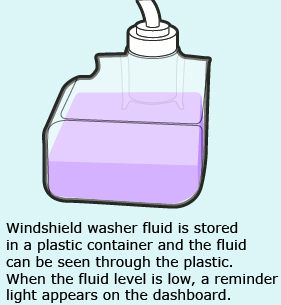 |
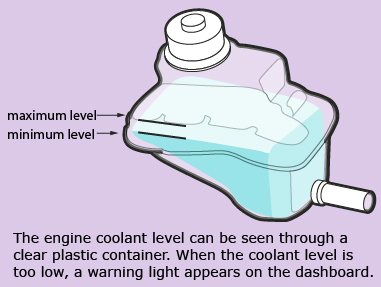 |
||
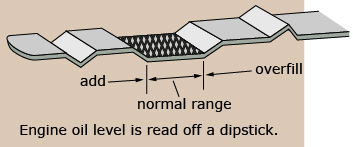 |
|||
- Take note of the different ways of measuring the volume of fluids the next time you are looking under the hood of a vehicle. Do you believe it is more important for these measures to be accurate or precise? Explain.
- Is it reasonable to say that looking at the windshield washer fluid reservoir gives an accurate reading? Explain.
- Is it reasonable to say that looking at the windshield washer fluid reservoir gives a precise reading? Explain.
- Determine the uncertainty of the fuel gauge on the car and the fuel gauge on the gas pump. Which has a smaller uncertainty? Why do you think this is the case?
![]() Save your responses in your course folder.
Save your responses in your course folder.
Share 2
With a partner or in a group, consider your answers to Try This 3 and answer the following questions.
- Many of the volume measurements in a vehicle do not involve numbers. Is it still possible to get an accurate measurement? Is it still possible to get a precise measurement?
- How would you describe the tolerance for the level of engine oil, windshield washer fluid, engine coolant, and fuel for a vehicle?
![]() If required, place a summary of your discussion in your course folder.
If required, place a summary of your discussion in your course folder.
1.5. Explore 4
Module 6: Measurement
In Try This 3 you may have noticed that it is possible to take accurate measurements without using numbers, although they will have a low degree of precision. By looking at the clear plastic container you can see whether the tank is empty, partially full, or completely full. Therefore, the measure is accurate to this level. However, this measurement will have a low precision because there are no markings.
In other situations it is important to have both accurate and precise measurements—estimates are insufficient. In the next Self-Check you will apply accuracy, precision, and uncertainty to specific measurements.
Self-Check 2
Answer “Practise Your New Skills” questions 3, 4, and 7 on pages 105 and 106. Answer
Try This 4
The speed of a vehicle is usually shown on the speedometer. However, many GPS systems and some road signs also display speed.

speedometer: Dynamic Graphics/liquidlibrary/Thinkstock; speed limit: © Olivier/5826883/Fotolia; GPS: iStockphoto/Thinkstock
- The speedometer shown measures both kilometres per hour (km/h) and miles per hour (MPH). For which speed are the markings calibrated?
- Determine the uncertainty for each scale of the speedometer, the speed on the GPS, and the speed displayed on the speed limit sign.
- Which measure do you expect to be the most accurate? Explain.
- Which measure has the lowest degree of precision? Explain.
- Which measure do you expect to have the lowest tolerance? Explain.
![]() Save your responses in your course folder.
Save your responses in your course folder.
Share 3
With a partner or in a group, consider your answers to Try This 4 and answer the following questions.
Your car displays the speedometer and GPS as shown in the previous images. Now you pass the speed limit sign. The speedometer read 15 MPH, the GPS read 24 km/h, and the speed limit sign read 27 km/h.
- If the speed limit is 25 km/h, which instrument displaying the speed will you go by?
- Will you change your speed? Explain.
![]() If required, place a summary of your discussion in your course folder.
If required, place a summary of your discussion in your course folder.
1.6. Explore 5
Module 6: Measurement
In Share 3 you may have noticed that it is important to try to stay within a tolerance when different measuring tools give different readings. In this example, the speed tolerance can be written as ![]() km/h because you can legally drive at any speed between 0 and 25 km/h in that area. To make sure that your car is travelling within this speed limit, you could choose the highest measurement and keep this below 25 km/h. This means you would have to slow down the car.
km/h because you can legally drive at any speed between 0 and 25 km/h in that area. To make sure that your car is travelling within this speed limit, you could choose the highest measurement and keep this below 25 km/h. This means you would have to slow down the car.
Self-Check 3
Answer “Practise Your New Skills” questions 9 and 10 on pages 106 and 107. Answer
You have been practicing using tolerances in Self-Check 3. You will now practice precision and uncertainty in a variety of settings.
Self-Check 4
Answer “Practice Your New Skills” questions 5, 6, and 8 on page 106. Answer
1.7. Connect
Module 6: Measurement
Complete the Lesson 4 Assignment that you saved in your course folder at the beginning of the lesson. Show work to support your answers.
![]() Save your responses in your course folder.
Save your responses in your course folder.
Project Connection
You are now ready to self-assess your project in Module 6 Project: Project Measurement. Go to the Module 6 Project, and complete Part 4: Complete the project rubric.
Save your responses in your course folder. You have now completed the Module 6 Project. Submit your Module 6 Project to your teacher.
1.8. Lesson 4 Summary
Module 6: Measurement
Lesson 4 Summary
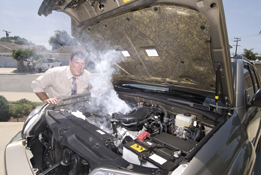
iStockphoto/Thinkstock
In this lesson you looked at applications of measurement when it comes to vehicles and vehicle maintenance. In some cases, such as the temperature of your engine, it is very important that the measuring tool be both accurate and precise. Imprecise measurements of engine temperature can cause engine damage and result in costly repairs.
On the other hand, the amount of windshield washer fluid in the reservoir is not as important, because harmful damage to the vehicle is very unlikely to occur if the reservoir is low or even empty. When analyzing measurements, you need to make informed decisions regarding what is important and what is not so important.
